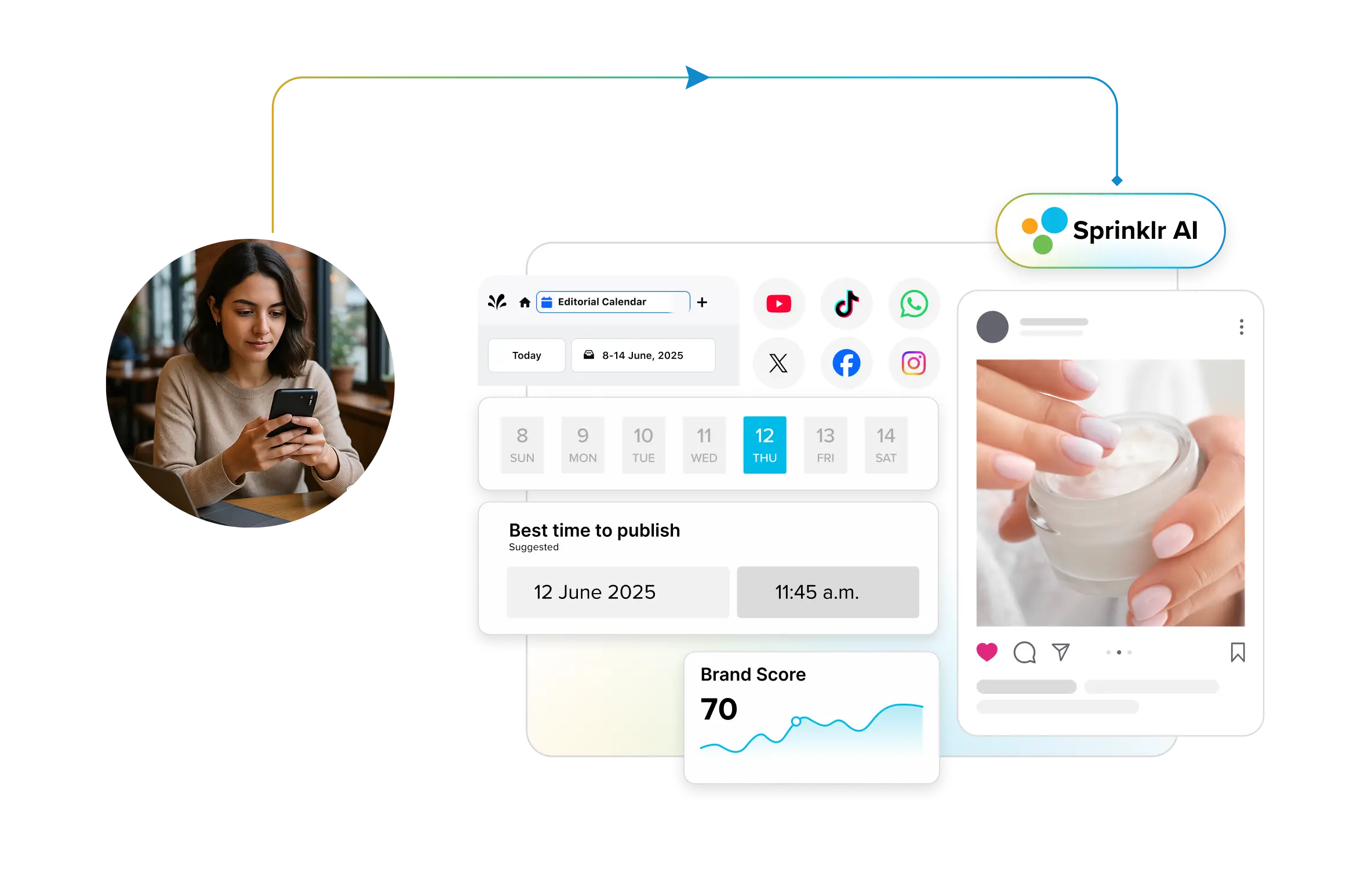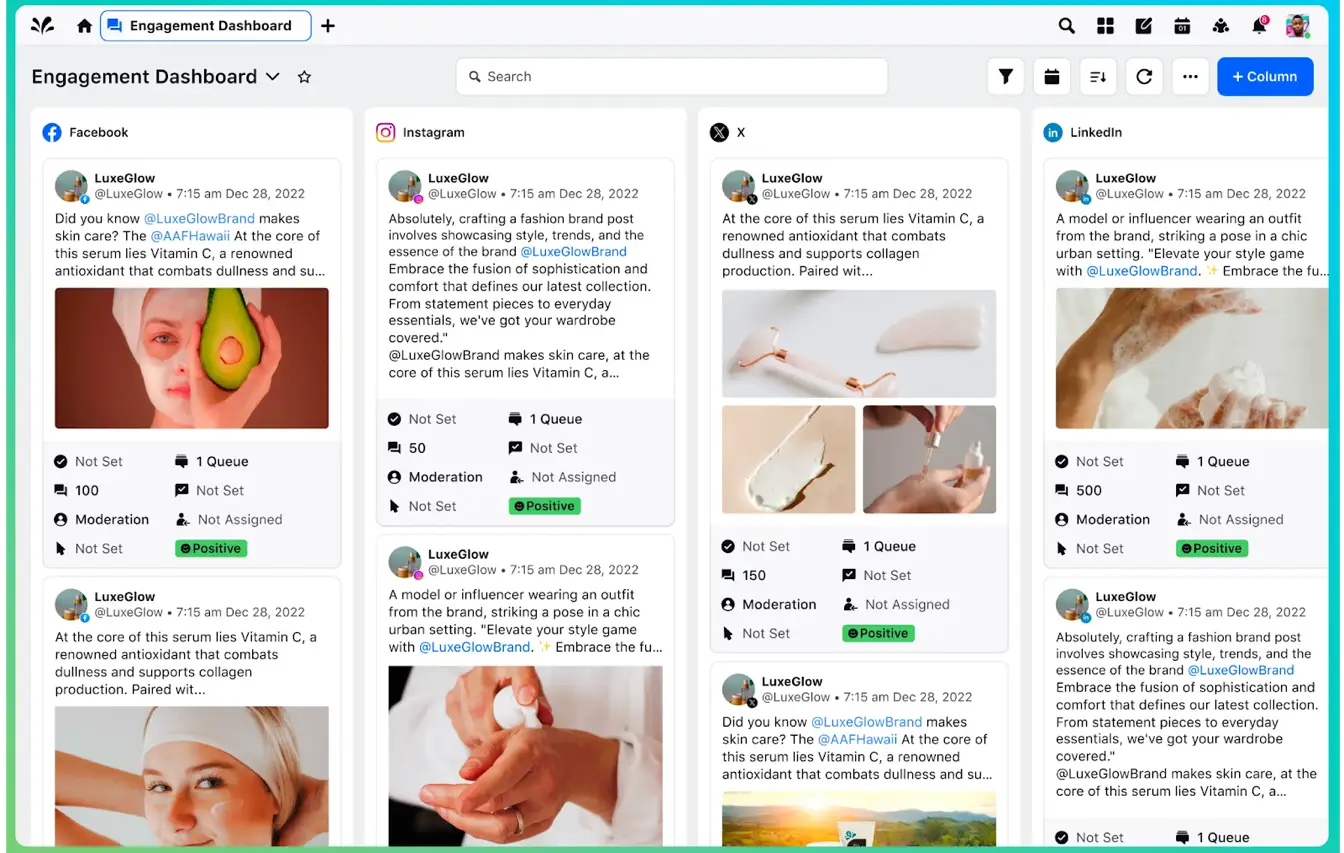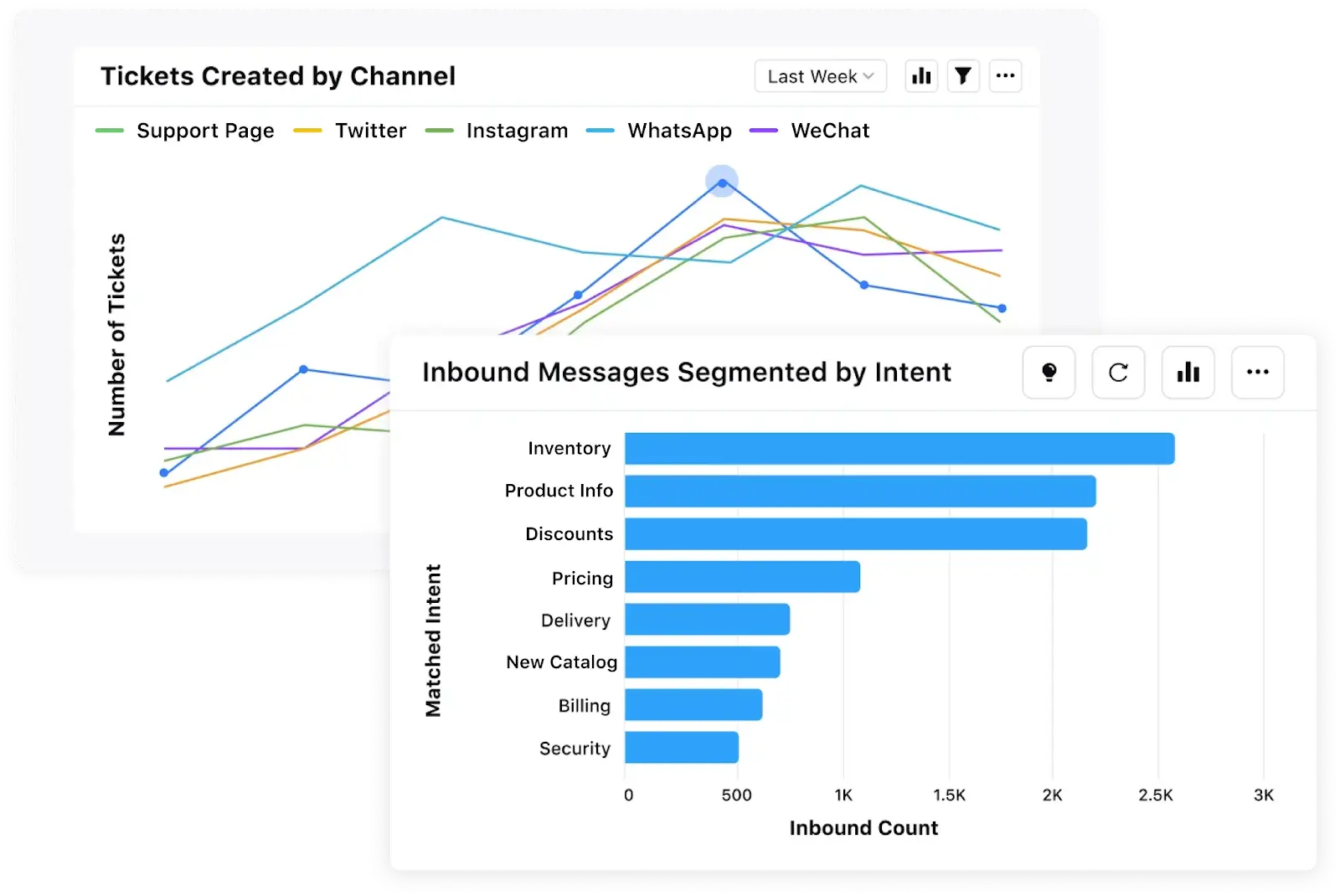The global leader in enterprise social media management
For over a decade, Sprinklr Social has helped the world’s biggest brands reimagine social media as a growth driver with a unified platform, industry-leading AI and enterprise-grade scale.

How Retail Brands Can Win Big on Social Media in 2025
A shopper explores a product on Instagram Stories. One swipe shows nearby stock, another reveals same-day delivery, and a tap completes the purchase. This is retail in 2025, where shopping feels effortless.
This shift is clear in the rise of social commerce. According to VML’s Future Shopper Report, 67% of consumers have made purchases directly through platforms like TikTok, Instagram, and YouTube. Interactive formats like live shopping and shoppable video are turning engagement into high-intent action.
This article explores how brands can use retail social media strategies in 2025. It examines platform trends, effective content formats, key performance metrics and the role of social in both digital and in-store sales.
The Role of social media in the retail industry
Social media plays a critical role across the entire retail funnel — from product discovery to purchase and post-sale engagement. Platforms like Instagram, TikTok and Pinterest aren’t just channels for visibility; they actively influence buying behavior through creator content, reviews and real-time interactions.
Consumers use social media to discover trends, compare products, and validate choices through peer opinions. This makes it a powerful tool for both sales and marketing. Features like live shopping, in-app checkout, and shoppable posts now allow shoppers to explore and purchase within the same platform, creating a faster and more seamless buying experience.
In a 2024 global survey of marketers, 83% of those polled cited increased exposure as a key benefit of social media marketing, followed by increased traffic (73%) and lead generation (65%). For retail marketers, too, social media serves as a dynamic source of customer insight and brand engagement. It enables personalized experiences, faster support and continuous community-building through loyalty programs, influencer partnerships and user-generated content. More importantly, social media data offers a real-time view of what customers want, providing critical information on everything from marketing strategy to inventory decisions.
Learn how to: Bring digital experiences in-store from leading retailers
Why social media is the new storefront for retail success
Social has already proven its value in driving commerce. The next challenge is using it like a storefront. That means moving beyond brand presence and building a system for consistent discovery, conversion, and retention at scale.
- Drives product discovery and shapes purchase decisions: Social platforms show trending content and personalized recommendations that affect what people buy. Use longer, educational formats on YouTube to support informed decisions. Tap into short-form trends and creator collaborations on Instagram and Facebook to spark impulse interest. Prioritize high-performing assets by tracking early signals like saves, shares, and video completion to increase visibility and drive conversions.
- Converts demand through precision targeting and in-platform checkout: Advanced audience segmentation lets brands tailor messaging by behavior, interest, or intent. Social commerce features like Facebook Shops and TikTok Checkout reduce friction by enabling direct transactions.
- Builds trust and loyalty through advocacy and social proof: User-generated content, influencer collaborations and peer reviews shorten the decision cycle and enhance credibility. Brands that activate community storytelling through hashtags, loyalty incentives and creator partnerships drive higher engagement and brand affinity than paid ads alone.
- Enhances customer experience with real-time engagement and insight: Customers engage through comments, DMs, and mentions, creating constant opportunities for connection. Brands that respond quickly to pre-purchase questions and resolve post-sale issues build stronger loyalty. By using a social listening tool, retail teams can track sentiment, spot product feedback early, and adjust messaging or inventory before small issues escalate. Fast, responsive engagement leads to a better customer experience and higher retention.
- Delivers measurable ROI through efficient acquisition and remarketing: Compared to traditional channels, social often yields lower CPAs and stronger remarketing flows via CRM integration and pixel targeting. When embedded across the funnel, social becomes a performance driver, not just a brand amplifier.
Pro Tip: Retail brands connect with customers across Instagram, TikTok, YouTube, WhatsApp and more, but without a unified system, these touchpoints stay siloed.
The result? Missed signals, delayed responses and inconsistent experiences that hurt conversion in a market where timing and personalization are everything.
Sprinklr Social enables retail brands to centralize social, messaging and customer data in one unified platform. This gives teams a complete, real-time view of customer behavior, sentiment and preferences across all touchpoints.
With AI-powered listening, brands can detect emerging trends, benchmark competitors and respond instantly. The result? Faster decision-making, more relevant campaigns and a consistent brand experience that drives loyalty and revenue across every channel.

Latest trends to integrate into your retail social media strategy
Key trends have emerged in the social media space that shape how platforms drive performance in retail. Let’s look at the measurable gains in customer acquisition cost, attribution accuracy and post-purchase engagement they offer in greater detail:
1. Short-form video is accelerating product discovery and conversions
Short-form content on platforms like TikTok, Instagram Reels, and YouTube Shorts has become a primary channel for retail product discovery. These formats drive higher watch times, increase customer engagement on social media, and boost conversions. For performance marketers, short-form video is no longer a creative experiment; it is a proven conversion asset.
2. Native social commerce is shortening the path to purchase
In-app checkout tools like TikTok Shop, Facebook Shops, and Pinterest’s native purchasing let shoppers move from content to checkout without leaving the platform. As more consumers shop directly within social feeds, brands that build social commerce into their sales strategy are seeing higher mobile conversions and better attribution tracking. This also gives them more control over the customer journey and experience.
3. Retail media data is improving social ad precision and ROI
Enterprise retailers are combining retail media network insights with social ad strategies to improve targeting and boost ROI. By using CRM and purchase data, marketers can create custom audiences, enable real-time product retargeting, and serve dynamic creatives that reflect shopper intent. When activated across platforms like Facebook, Instagram, and YouTube, these strategies deliver stronger returns and more accurate attribution. Facebook delivered the highest ROI for 28% of marketers in 2024, followed by Instagram (22%) and YouTube (12%).
4. Creator-led UGC is building trust and increasing content efficiency
According to Forbes, over 60% of social media users trust influencers more than corporations or celebrities. As a result, the most effective retail content today comes from real people rather than polished brand assets. This approach builds trust, increases content velocity, and often delivers better results than paid media.
An AI-powered platform like Sprinklr enables enterprise teams to manage this shift at scale. It brings together content planning, publishing, creator management, customer engagement and social media reports into one unified workflow. This allows brands to adapt to trend cycles quickly, maintain message consistency across regions and ensure every campaign meets legal, brand and performance standards.
5. Conversational commerce turns support into sales
Retail teams can use social media DMs and chatbots to provide retail customer service, answer product related questions, and drive purchases within the same conversation. By responding to availability queries with direct links or completing transactions in chat, brands streamline the buying journey and create a personalized experience. This approach converts service interactions into revenue, shortens sales cycles, and boosts conversion rates from high-intent inquiries.

From personalized product recommendations to real-time support across channels like WhatsApp, Instagram and web chat, conversational commerce turns every interaction into a selling opportunity. Want to learn more?
Top 5 retail social media strategies for 2025
Some of the trends highlighted above are the result of these proactive brand strategies. Enterprises are focused on increasing retail social engagement, mature social commerce and authentic community building. Let's look at how to convert these into tangible business growth:
1. Use storytelling and lifestyle-focused content to build brand equity
Shift from promotional content to narrative-led campaigns that link your product with aspirational lifestyles, daily rituals or cultural relevance. Feature real customers, or behind-the-scenes design stories instead of surface-level trends. Equip brand teams with structured storytelling frameworks and brand identity kits to maintain consistency.
2. Balance real-time content cadence with seasonal campaign peaks
Enterprise brands often focus too heavily on seasonal campaigns and miss daily opportunities to stay relevant. Build a two-part content strategy: one layer for high-impact seasonal moments like product launches or holiday sales, and another that runs daily, powered by platform trends and UGC.
Use social listening for retail to drive real-time content that taps into trends and conversations as they happen. Pair this with planned campaigns around key retail events like new launches or seasonal sales. Together, this mix of reactive and scheduled content helps maintain steady reach, drive ongoing engagement, and keep your brand relevant between major campaigns.
3. Influencer marketing with trackable links boosts measurable sales
Retail brands can drive conversions by partnering with trusted influencers who share custom discount codes or affiliate links in their content. These collaborations, whether through product gifting or commission-based deals, combine social proof with clear attribution. With trackable links, brands can monitor performance in real time, identify high-impact creators, and refine future campaigns to maximize revenue and customer acquisition.
Pair macro influencers with mid-tier and nano creators who can tell stories that feel native to the community. You can also track outcomes beyond likes or views — use redemptions, store traffic, or DMs to measure real impact. Set competitive performance benchmarks beyond vanity metrics (e.g., code-level redemptions, store visits, DM inquiries) to evaluate their actual commercial impact.
See Also: 8 Examples of Social Media Advocacy Success
4. Integrate paid and organic efforts to enable full-funnel measurement
When paid and organic teams work separately, it often leads to duplicated efforts and inconsistent social media messaging. Align both under common funnel goals such as awareness, consideration, conversion, and loyalty.
Use engagement data to drive targeting of paid campaigns. Retarget those who interacted with your organic posts using conversion-focused ads. Platforms like Meta’s Advantage+ and TikTok Promote allow seamless retargeting of high-intent organic audiences. This integrated model reduces CAC and clarifies the contribution of each channel to revenue outcomes.
Additional Resource: Instantly Estimate Your Social Media ROI
Skip the guesswork and see how much value a unified social strategy could drive for your business. Sprinklr’s ROI Calculator, built in collaboration with Forrester, shows potential cost savings and revenue gains from better automation, engagement, and customer insights. Perfect for enterprise teams building a business case.
5. Connect live inventory to dynamic product ads on social
Most retailers still run ads without inventory logic, leading to customer drop-off and operational inefficiencies. In 2025, connect your ERP or inventory management system directly to Meta Advantage+ or TikTok Catalog Ads. This ensures only in-stock SKUs are promoted, real-time availability is reflected in creatives and pricing is dynamically adjusted during high-volume sales periods. The result: reduced customer dissatisfaction, fewer wasted impressions and improved ROAS in time-sensitive campaigns.
Successful social media campaigns from top retailers
Retail leaders have been using social media to deliver high-impact campaigns that feature advanced emotional storytelling, user-generated content and social values. Here’s a detailed overview of some of them:
1. Lululemon’s "Feel" campaign
To shift from performance-led messaging to an emotion-first brand narrative, Lululemon launched its largest global campaign—Feel. The success of the campaign wasn’t just in the concept, but in how every channel, creator, and asset aligned to deliver a consistent, sensory-led experience.
- Platform-specific storytelling: Instagram and TikTok featured short-form, vertical videos with motion-focused visuals and creator reactions. YouTube hosted longer brand films with minimal narration to evoke emotion through pacing and visuals.
- Creator collaboration: Lululemon partnered with lifestyle influencers, dancers, and trainers to co-create narratives around everyday movement, moving beyond traditional fitness content and embedding creators into the brand story.
- Retail and digital sync: In-store displays, packaging, and PDPs mirrored the same emotional language and visual cues, ensuring consistency from discovery to purchase.
- Performance impact: While ROI wasn’t disclosed, brand tracking showed increased emotional brand association and stronger engagement on video-first platforms, especially across APAC.
Enterprise takeaway: Emotional storytelling works when backed by cross-functional execution. Lululemon’s success came from aligning creative, commerce, and retail operations to deliver one unified message.
Action: For enterprise campaigns, build end-to-end campaign kits with adaptable narratives, platform-native content, and integrated rollout plans that connect emotion to measurable outcomes.
2. Dove’s "#TurnYourBack" initiative
Dove launched the #TurnYourBack campaign to challenge AI beauty filters and promote authentic self-expression. The campaign succeeded by treating social media as its lead channel and driving platform-native content across TikTok, Instagram, and YouTube Shorts.
- Creator-led storytelling: Dove partnered with hundreds of Gen Z creators, from dermatologists to mental health advocates, to share coordinated short-form videos rejecting filtered beauty. This synchronized launch created collective momentum and cultural relevance.
- Cross-channel amplification: The campaign used earned media, influencer seeding, and press kits to secure coverage in major outlets like BBC and Forbes, extending reach beyond social platforms.
- Localized execution: While the core message stayed consistent, Dove gave regional teams the flexibility to adapt creative assets for cultural nuance without losing the brand voice.
Enterprise takeaway: Successful issue-led campaigns require more than bold messaging. Dove’s impact came from early creator orchestration, media integration, and global alignment—all built on a scalable campaign framework.
Action: When building value-driven campaigns, prioritize creator activation, earned media planning, and market adaptability from day one to drive authenticity and global reach.
3. Rare Beauty’s "Mental Health 101" program
Rare Beauty’s Mental Health 101 campaign blended product storytelling with consistent mental health advocacy, educational content, expert interviews, and user-led narratives. The initiative was anchored in the #RareImpact hashtag and activated across all major social channels for maximum visibility and engagement.
- Integrated campaign design: Rare Beauty tied product launches to cause-driven messaging, ensuring that each social post strengthened brand perception and emotional resonance.
- Sustained community focus: By amplifying life experiences and expert voices, the campaign positioned Rare Beauty as more than a cosmetics brand—creating deeper connection and long-term loyalty.
Enterprise takeaway: Purpose-led campaigns deliver durable brand equity when integrated across product, content, and community-based marketing strategy. Rare Beauty’s approach shows that consistent cause alignment builds defensibility in masses.
Action: Invest in campaigns that balance brand advocacy with utility. Use community input to shape content and maintain consistency across touchpoints to strengthen both emotional engagement and customer retention.
Also read: L’Oréal’s new social media marketing strategy
Final Thoughts
Social media is now the primary domain where brand affinity, customer loyalty and revenue are directly cultivated. As we navigate the remainder of the year, leading retail brands will be those that fully integrate social media not as an isolated marketing channel, but as the core driver of a unified, omnichannel customer engagement. This strategic advancement allows for fluid customer journeys that convert initial engagement into tangible sales and enduring relationships, moving beyond fragmented content to truly connected experiences.
Contemporary successful retailers have demonstrated a deep understanding of their customers across every digital touchpoint. Their integrated approach, powered by solutions like Sprinklr Social, provides a singular view for managing complex social ecosystems. With features encompassing advanced social listening, AI-powered content optimization, comprehensive engagement tools and comprehensive analytics for direct ROI measurement, Sprinklr empowers brands to translate insights into action.
Interested? Request a demo now.
Frequently Asked Questions
Retailers can generate direct sales through built-in shopping features like in-app purchases on platforms like Instagram, Facebook, TikTok and Pinterest. By setting up shoppable posts, running live shopping sessions and partnering with influencers, brands make it easier for users to discover and purchase products without leaving the app.
The best choice depends on your audience and product category. Different social platforms have their unique strengths. Most successful retailers use a multi-platform strategy tailored to each channel’s strengths.
Retail brands succeed with content that blends product promotion with storytelling and engagement. The key is to maintain a consistent brand voice while mixing informative, entertaining and inspirational posts.
The most important social media KPIs for retail are those that directly impact sales and customer behavior. These include click-through rates on product links, conversion rates from social traffic, revenue generated through social channels and customer acquisition cost.
Social media often serves as the first touchpoint in the buying journey. Shoppers discover products, read reviews, watch demonstrations and build trust with a brand online before visiting a physical store. Features like geo-targeted ads, store locators and promotional content tied to local events or product launches further drive foot traffic to retail locations.









